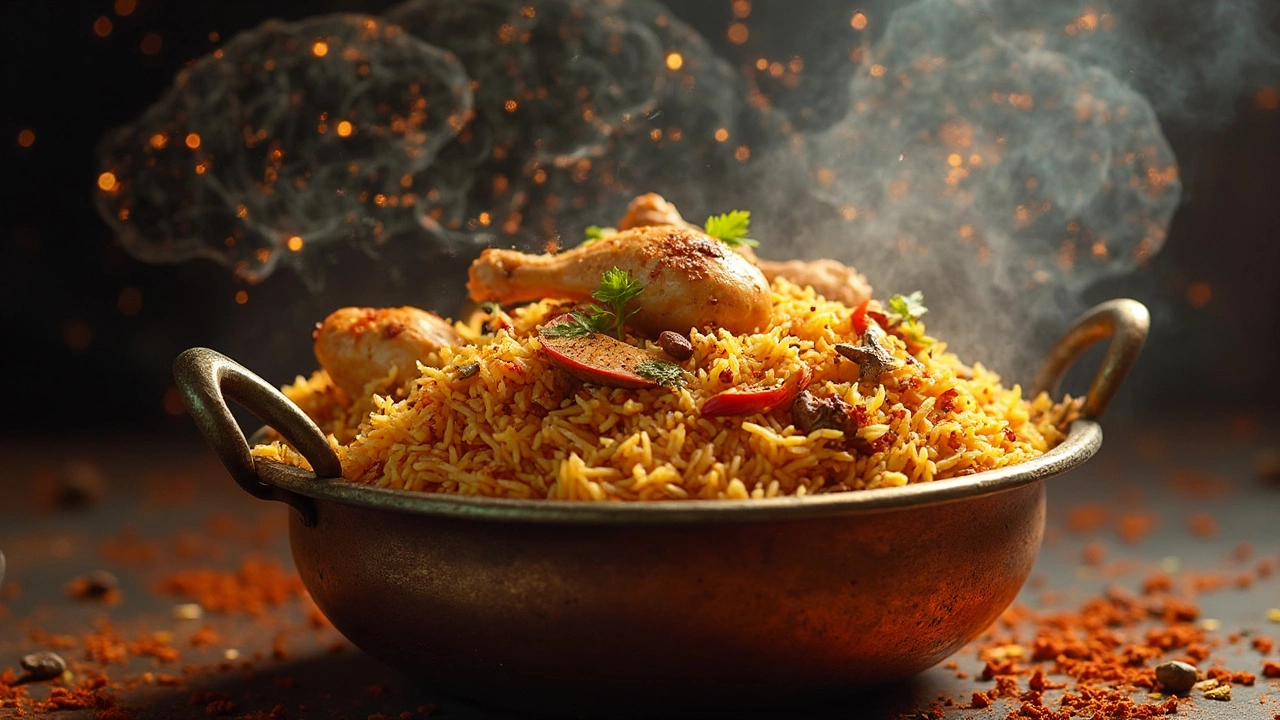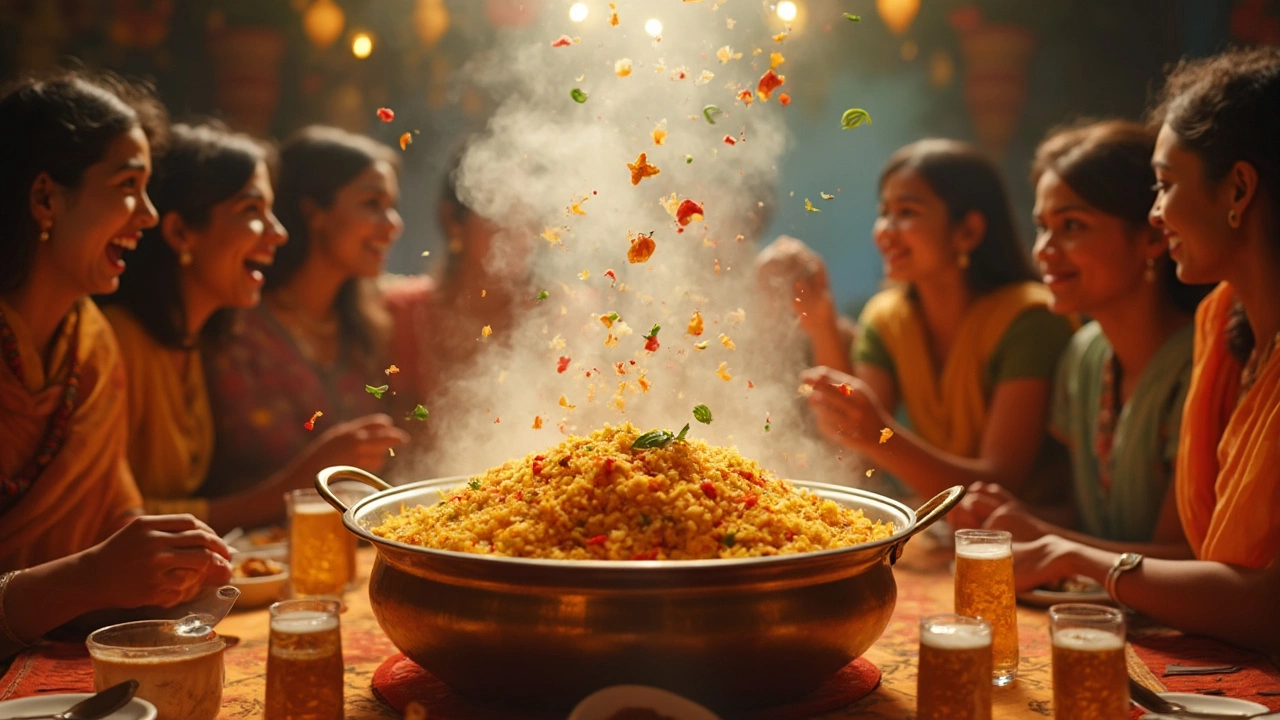Ask anyone who’s tasted authentic biryani: giving it up sounds like a joke. I swear, the love people have for biryani sometimes borders on obsession. My son Aarav, a fierce food critic by age ten, would happily trade his weekend outings for a piping hot plate of biryani. There’s even a WhatsApp family group that springs to life at the mere mention of it. So what’s going on? Why does biryani pull so many of us under its spell? Let’s hunt for the answers buried in this legendary, aromatic mountain of rice and meat.
Layers of Flavor: Why Every Spoonful Inspires Cravings
Biryani isn’t just rice and meat tossed together and dubbed a meal. Its recipe is a sensory masterpiece. Real biryani means multiple layers, each bringing a new dimension—marinated meat, sinking in a pool of aromatic yogurt and spices; fluffy basmati rice, fragrant with saffron or kewra water; crispy caramelized onions; and a sprinkle of fresh herbs. Every bite hits you with a different combination, so it never tastes the same twice.
Think of biryani as the edible version of a blockbuster movie, where each bite is a scene with new twists. The contrast between the warm spices—like cinnamon and cardamom—and mellow, buttery rice keeps your brain guessing and your taste buds hooked. It’s not just variety for variety’s sake. Your senses want that hit of surprise and comfort combined, and that’s exactly what biryani delivers.
Chef Sanjeev Kapoor once joked that any city claiming best biryani status always fights fierce, because everyone tweaks the recipe. Some add boiled eggs, others drizzle rose water, some even hide fried potato chunks between the layers. This diversity works in biryani’s favor, making each version seem fresh and worth chasing. Even if you just had biryani last week, you know a different family’s recipe will offer a completely new experience. So our desire comes not just from the food, but the thrill of discovery every single time.
The Science Behind the Addiction: Brain Chemistry at Work
Let’s talk about what’s happening in your head when you pick up that first forkful. Biryani triggers your reward center in a way bland food simply can’t. The combination of fat (ghee or butter), proteins, and complex carbs gives your brain a flood of dopamine, a neurotransmitter that literally makes you happy. That feeling of pleasure? It’s real—and you might even feel a rush similar to the buzz from chocolate or French fries, only with far more depth thanks to all those flavor-packed spices.
This isn’t just fun food science trivia. Multiple studies from India’s National Institute of Nutrition have studied the impact of high-fat, high-carb, and spiced dishes on satiety and cravings. They found that meals rich in umami—like slow-cooked biryani—encourage the release of feel-good hormones. Even the aromas, from spices like cardamom and cloves, activate brain centers tied to pleasure and memory. That’s why even the smell of biryani from a neighbor’s kitchen can make you instantly hungry, no matter how recently you ate.
There’s also the comfort factor. Biryani is a typical “occasion food” in many South Asian homes, so our brains wire themselves to see it as rewarding. At my house, making biryani is a whole ritual—soaking the rice, slow cooking the meat, even the bickering over who gets the last caramelized onion. Those positive memories boost our craving, so we’re not just eating for taste but for an emotional connection.
| Component | Role in Cravings |
|---|---|
| Marinated Meat | Rich in protein, increases dopamine release |
| Basmati Rice | Complex carbs for steady energy, boosts serotonin |
| Ghee/Butter | Fat enhances satiety and flavor release |
| Spices | Stimulate olfactory and pleasure centers |

The Secret of Spices: Invisible Hooks
It’s hard to talk about why biryani is addictive without getting into its masala—a blend of spices unique to every family, sometimes kept secret for generations. The usual suspects are cardamom, cinnamon, bay leaves, star anise, cloves, nutmeg, and sometimes even stone flower (if you’re from Hyderabad). Each of these packs more than aroma; they interact physiologically with your senses.
Cinnamon naturally contains cinnamaldehyde, which wakes up your palate and nose. Cardamom has cineole, a compound that’s almost euphoric when inhaled. Studies in food neuroscience have found that complex spice blends make your brain slow down and savor, rather than just mindlessly eating. It’s like how your body reacts to coffee or fine chocolate.
What about heat? Even those who fear chili find biryani manageable. The chili is balanced by the richness of rice and meat, so your tongue tingles without feeling the burn. That Goldilocks zone of flavor wakes up your taste buds just enough to keep you eating. It’s not just about taste either. Spices like cloves and pepperola have mild mood-boosting effects. Over time, your body craves not just the meal, but the aftermath—the calm buzz and satisfaction you get after eating.
Got leftovers? You’ll notice they taste even better the next day. That’s real: as spices sit with rice and meat, they release more volatile compounds, deepening the flavor. It makes reheated biryani almost a new dish, sparking cravings all over again.
Cultural Rituals and Emotional Attachments
Biryani isn’t just food—ask any South Asian or food lover in the Middle East. It’s birthday feasts, Sunday indulgence, wedding rituals, and even funeral comfort. It’s how families show love and flex their culinary skills. My own mom taught me her biryani recipe on a rain-soaked Sunday, after hours of storytelling, and now Aarav expects it every monsoon. These moments wrap biryani in nostalgia and tradition, which only fuels our soft spot for it.
There’s also a social payoff. Serving biryani—especially at gatherings—feels like a power move. People remember a good biryani meal. That’s part of the addiction; it’s much bigger than the food itself. When you’re eating biryani with others, the shared joy multiplies the pleasure (no, that’s not just sentimental talk—social eating does boost dopamine).
Here’s a tip: the best biryani follows the tradition of biryani being layered, not mixed like pulao. It gives you little surprises in every spoonful. If you’ve only tried supermarket or “fusion” versions, hunt for restaurants or home cooks who slow cook their biryani in a sealed pot (“dum” style). That’s a game changer—aromas, flavors, and mouthfeel are on a whole new level.

How to Satisfy the Biryani Craving Without Overdoing It
As much as we all love biryani, those calories can sneak up on you. A small serving (about a cup) can pack as much as 400–600 calories depending on oil and meat cuts. But with a few smart tweaks, you can enjoy your biryani fix guilt-free. First off, try using leaner meats like chicken breast or even jackfruit for a vegetarian option. Swapping ghee for olive oil sometimes keeps the richness while cutting a few calories.
Bulk up your biryani with more veggies—peas, carrots, beans, or even cauliflower disappear into the layers. I’ve had biryani with roasted sweet potatoes that tasted so good my son didn’t even notice the healthy twist. Another tip: go easy on the raita (yogurt side), which helps digestion but can add hidden sugar if flavored.
If you’re cooking at home, the real secret is patience. Slow cooking allows the rice to soak up all those spices, making even a small portion feel hearty and satisfying. And if you want to keep the cravings at bay throughout the week, make an extra batch—biryani freezes beautifully and gets even more aromatic after a day or two.
- Choose basmati rice for less starchy bites and a lighter feel.
- Use bone-in meats for richer flavor and less oil.
- Toast your spices before adding to build maximum aroma.
- Let your biryani rest 20 minutes before serving for flavors to settle.
So yes, biryani has that unique magic—taste, smell, ritual, and the ache for “just one more bite.” Next time you find yourself bargaining for the last spoonful at the table, just know: you’re not alone, and now you have a solid excuse—it’s chemistry, culture, and a dash of good old memory at play.
